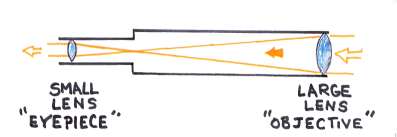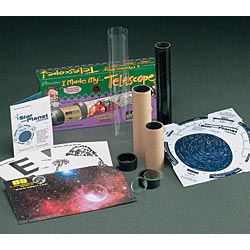 |
|||||
|
What is a Refractor Telescope? An easy explanation for beginners. The Refractor telescope is the first type of telescope invented. In a nutshell it is simply two lenses inside a tube.
The large lens (on the right) is the light gathering lens. This lens is called the objective lens. The bigger this lens is the better the telescope because the more light it will gather and the deeper into space you will see. It also will enable you to magnify things larger and get a closer look at objects in the night sky. The small lens (on the left) is the magnifying lens. This lens determines the magnification of the telescope. With most modern telescopes this lens is replaceable and these replacements are called "eyepieces". By putting in a different eyepieces you will change the magnification. One eyepiece lets say will be a 50X magnification and another could be a 100X magnification. Of course there are many different magnifications that you could use but every telescope has its limits. You couldn't magnify things a million times it would be beyond the abilities of the refractor telescope. How does the refractor telescope work? It works by bending light. The lenses bend the light thus taking a larger amount of light and concentrating it in a smaller area. Your eye works the same way and think of a telescope as being just a much bigger eye. As a matter of fact the eyes that are telescopes can be tremendous in size and gather millions of times more light than your eye.
The illustration above shows the light being bent by the objective lens. And an interesting thing to note is that as the light travels down the tube the cone gets smaller and smaller and then gets bigger and bigger again. This is very important because what happens here is that the image you see through the telescope is inverted; everything you see through the telescope is upside down and backwards. When using the telescope for sky objects this is not a factor but when you are using it to look at things on the earth you might find it surprising and uncomfortable. This use of a refractor for terrestrial viewing is easily overcome though by an eyepiece called an inverter. This inverter turns everything right side up again. One more thing about refractors They are very rarely built with just a single lens as the objective. This is because a light is bent through the lens at different rates. Different frequencies of light such as blue or red or green will bend slightly diffferently through the lens. This causes an effect called chromatic effect and what it will cause is unnatural colors when you look at things. This chromatic problem is fixed by assembling an objective lens that is composed of two types of glass that bend light in different ways that offset and cancel each other out. By the time the light passes through all the lenses in the assembly it has been corrected. This type of objective lens is called an achromatic lens.
The illustration of the achromatic lens shows the light coming in from the right and being bent through the lenses on through to the left. The two different types of lenses in the assembly counteract and balance each other out and create light that is chromatically correct. Want to Make your own Refractor Telescope?
Here is a video of me showing how a basic refractor telescope works. It shows the concept and the major parts of the telescope.
|
|||||
Articles: A guide to buying a Dobsonian Telescope A tour through the universe for casual or first time astronomers Telescopes are not just for nerds! Understanding Magnification and Telescopes or How high can a telescope go? Why is the eyepiece on the side of some telescopes? Understanding the parts of a reflector telescope The difference in performance, use, and cost between reflector and refractor telescopes You don't know much about telescopes but want to buy your first one? Here is my recommendation Make and use your own telescope for less than twenty bucks with this easy kit Astronomy with Binoculars a bit about what to know The biggest challenge to telescope users is overcome with Meade Telescopes
|
|||||




 Edmund Scientific has a great little kit that's very inexpensive and it has everything you need to get started with astronomy. It comes with all the materials to make your own basic refractor telescope and it comes with the Edmund star and planet finder.
Edmund Scientific has a great little kit that's very inexpensive and it has everything you need to get started with astronomy. It comes with all the materials to make your own basic refractor telescope and it comes with the Edmund star and planet finder.